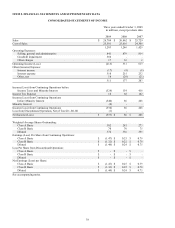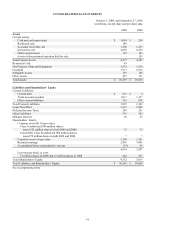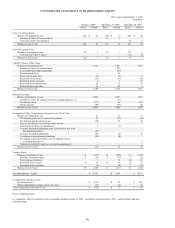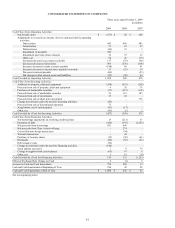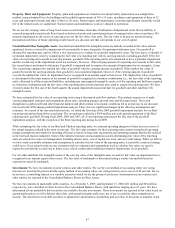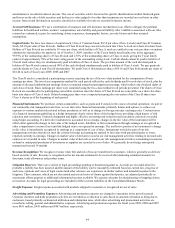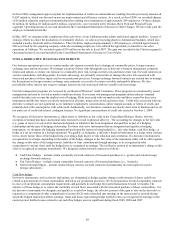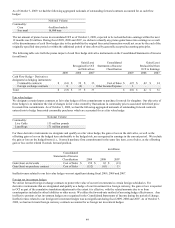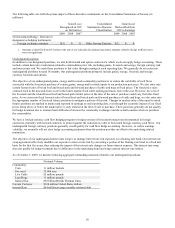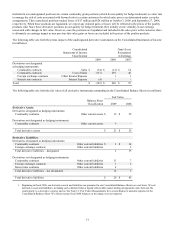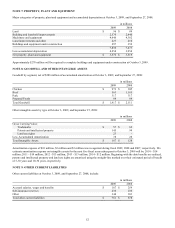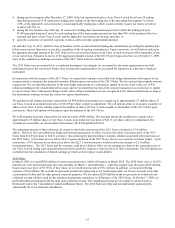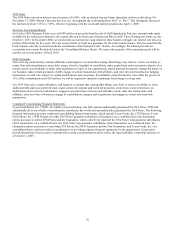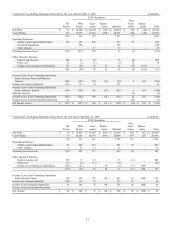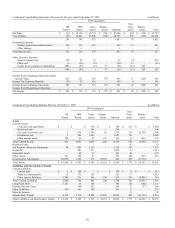Tyson Foods 2009 Annual Report Download - page 48
Download and view the complete annual report
Please find page 48 of the 2009 Tyson Foods annual report below. You can navigate through the pages in the report by either clicking on the pages listed below, or by using the keyword search tool below to find specific information within the annual report.
48
In fiscal 2008, management approved plans for implementation of certain recommendations resulting from the previously announced
FAST initiative, which was focused on process improvement and efficiency creation. As a result, in fiscal 2008, we recorded charges
of $6 million related to employee termination benefits resulting from termination of approximately 200 employees. Of these charges,
$2 million, $2 million, $1 million and $1 million, respectively, were recorded in the Chicken, Beef, Pork and Prepared Foods
segments’ Operating Income (Loss) and included in the Consolidated Statements of Income in Other Charges. We have fully paid the
employee termination benefits.
In May 2007, we announced the completion of the sale of two of our Alabama poultry plants and related support facilities. As part of
strategic efforts to reduce the production of commodity chicken, we sold our processing plants in Ashland and Gadsden, which also
included a nearby feed mill and two hatcheries. These facilities employed approximately 1,200 employees, of which approximately
800 were hired by the acquiring company, while the remaining employees were offered the opportunity to transfer to our other
operations in Alabama. We recorded a gain of $10 million on the sale in fiscal 2007. The gain was recorded in the Chicken segment’s
Operating Income (Loss) and included in the Consolidated Statements of Income in Cost of Sales.
NOTE 6: DERIVATIVE FINANCIAL INSTRUMENTS
Our business operations give rise to certain market risk exposures mostly due to changes in commodity prices, foreign currency
exchange rates and interest rates. We manage a portion of these risks through the use of derivative financial instruments, primarily
futures and options, to reduce our exposure to commodity price risk, foreign currency risk and interest rate risk. Forward contracts on
various commodities, including grains, livestock and energy, are primarily entered into to manage the price risk associated with
forecasted purchases of these inputs used in our production processes. Foreign exchange forward contracts are entered into to manage
the fluctuations in foreign currency exchange rates, primarily as a result of certain receivable and payable balances. We also
periodically utilize interest rate swaps to manage interest rate risk associated with our variable-rate borrowings.
Our risk management programs are reviewed by our Board of Directors’ Audit Committee. These programs are monitored by senior
management and may be revised as market conditions dictate. Our current risk management programs utilize industry-standard
models that take into account the implicit cost of hedging. Risks associated with our market risks and those created by derivative
instruments and the fair values are strictly monitored at all times, using value-at-risk and stress tests. Credit risks associated with our
derivative contracts are not significant as we minimize counterparty concentrations, utilize margin accounts or letters of credit, and
primarily deal with counterparties with solid credit. Additionally, our derivative contracts are mostly short-term in duration and we do
not make use of credit-risk-related contingent features. No significant concentrations of credit risk existed at October 3, 2009.
We recognize all derivative instruments as either assets or liabilities at fair value in the Consolidated Balance Sheets, with the
exception of normal purchases and normal sales expected to result in physical delivery. The accounting for changes in the fair value
(i.e., gains or losses) of a derivative instrument depends on whether it has been designated and qualifies as part of a hedging
relationship and the type of hedging relationship. For those derivative instruments that are designated and qualify as hedging
instruments, we designate the hedging instrument based upon the exposure being hedged (i.e., fair value hedge, cash flow hedge, or
hedge of a net investment in a foreign operation). We qualify, or designate, a derivative financial instrument as a hedge when contract
terms closely mirror those of the hedged item, providing a high degree of risk reduction and correlation. If a derivative instrument is
accounted for as a hedge, depending on the nature of the hedge, changes in the fair value of the instrument either will be offset against
the change in fair value of the hedged assets, liabilities or firm commitments through earnings, or be recognized in other
comprehensive income (loss) until the hedged item is recognized in earnings. The ineffective portion of an instrument’s change in fair
value is recognized in earnings immediately. We designate certain forward contracts as follows:
●
Cash Flow Hedges – include certain commodity forward contracts of forecasted purchases (i.e., grains) and certain foreign
exchange forward contracts.
●
Fair Value Hedges – include certain commodity forward contracts of forecasted purchases (i.e., livestock).
●
Net Investment Hedges – include certain foreign currency forward contracts of permanently invested capital in certain
foreign subsidiaries.
Cash flow hedges
Derivative instruments, such as futures and options, are designated as hedges against changes in the amount of future cash flows
related to procurement of certain commodities utilized in our production processes. We do not purchase forward commodity contracts
in excess of our physical consumption requirements and generally do not hedge forecasted transactions beyond 12 months. The
objective of these hedges is to reduce the variability of cash flows associated with the forecasted purchase of those commodities. For
the derivative instruments we designate and qualify as a cash flow hedge, the effective portion of the gain or loss on the derivative is
reported as a component of other comprehensive income (OCI) and reclassified into earnings in the same period or periods during
which the hedged transaction affects earnings. Gains and losses representing hedge ineffectiveness are recognized in earnings in the
current period. Ineffectiveness related to our cash flow hedges was not significant during fiscal 2009, 2008 and 2007.


